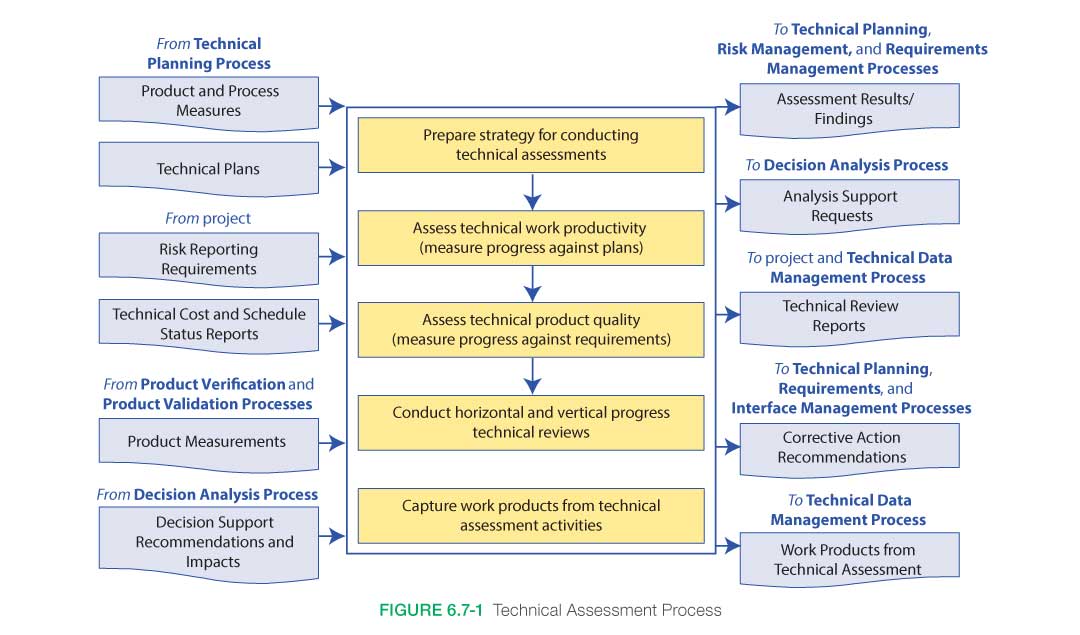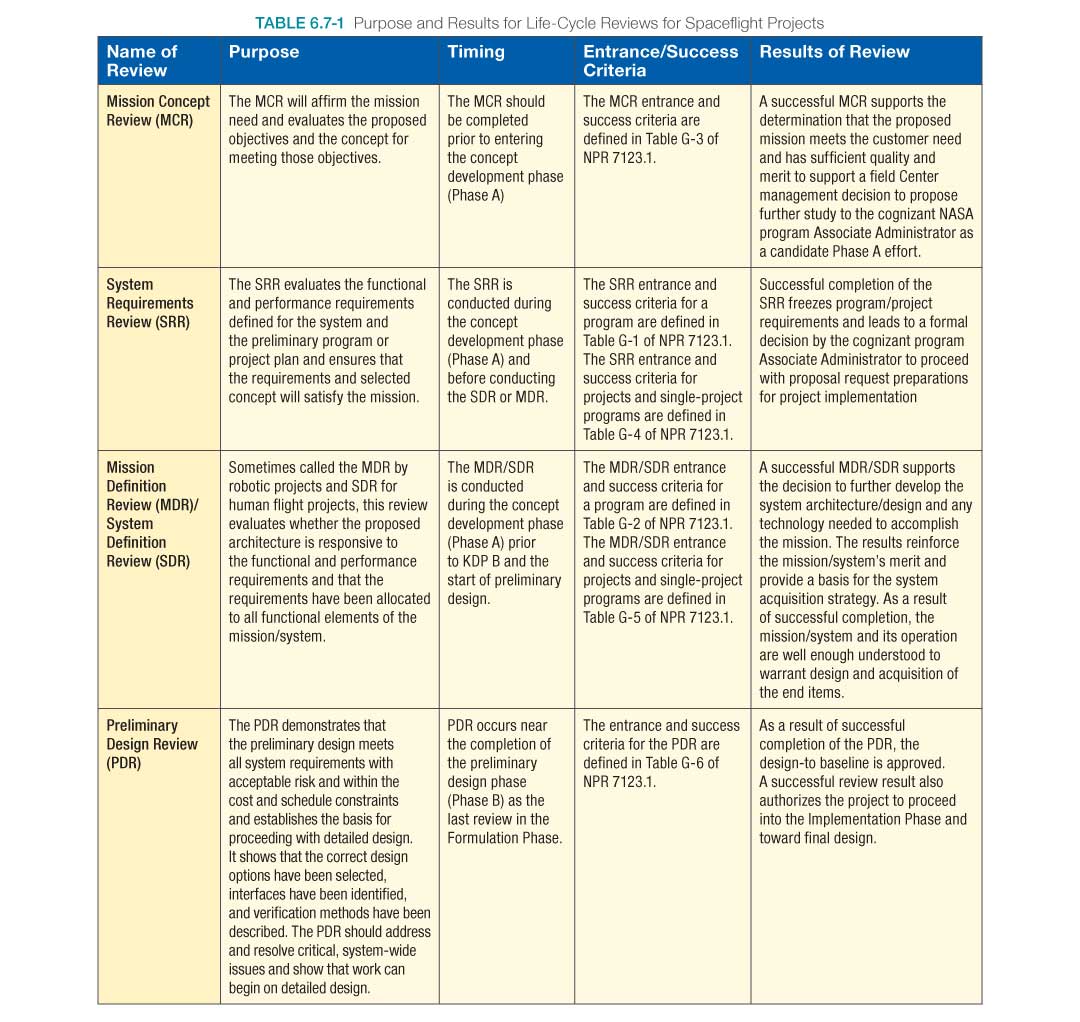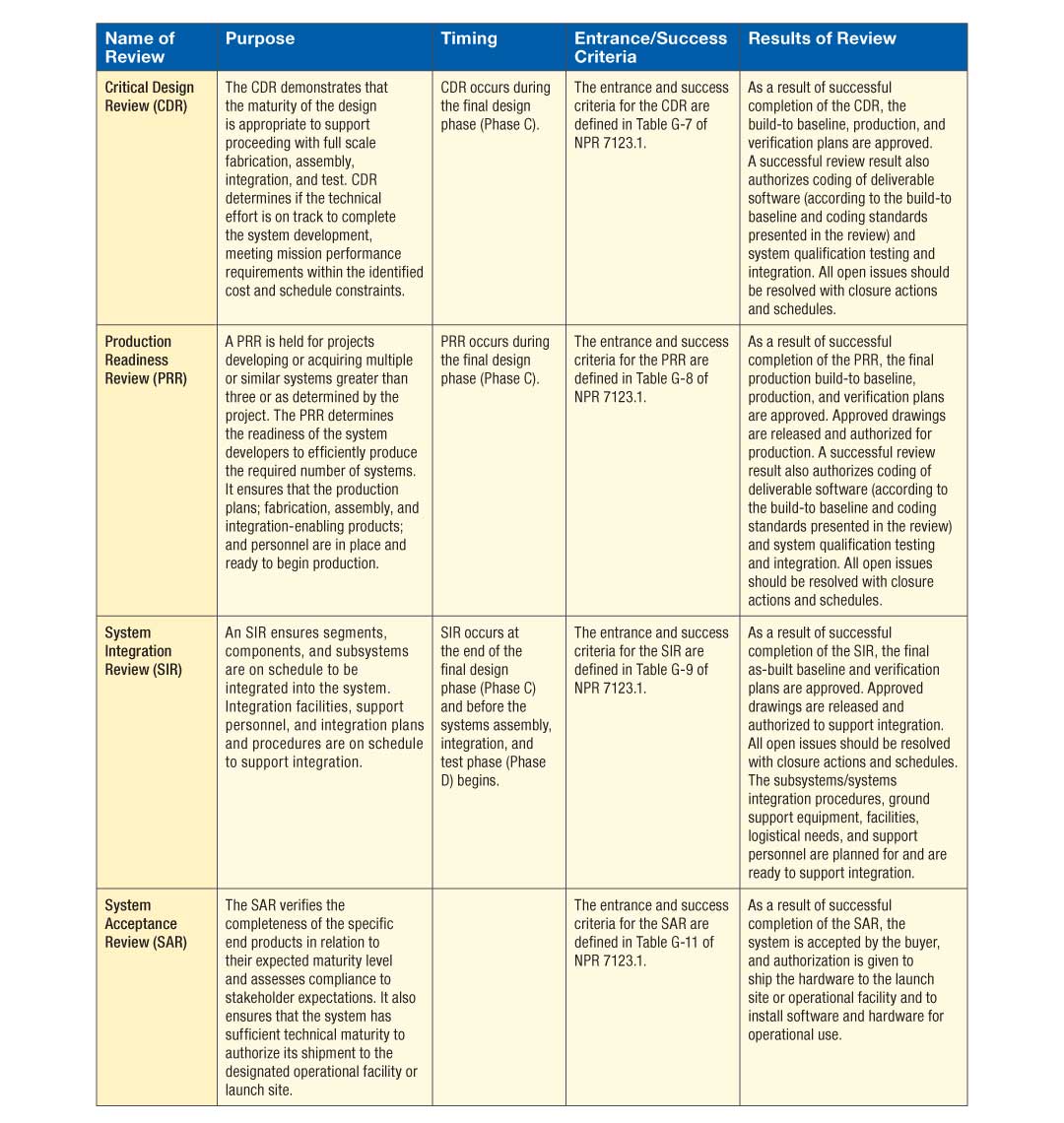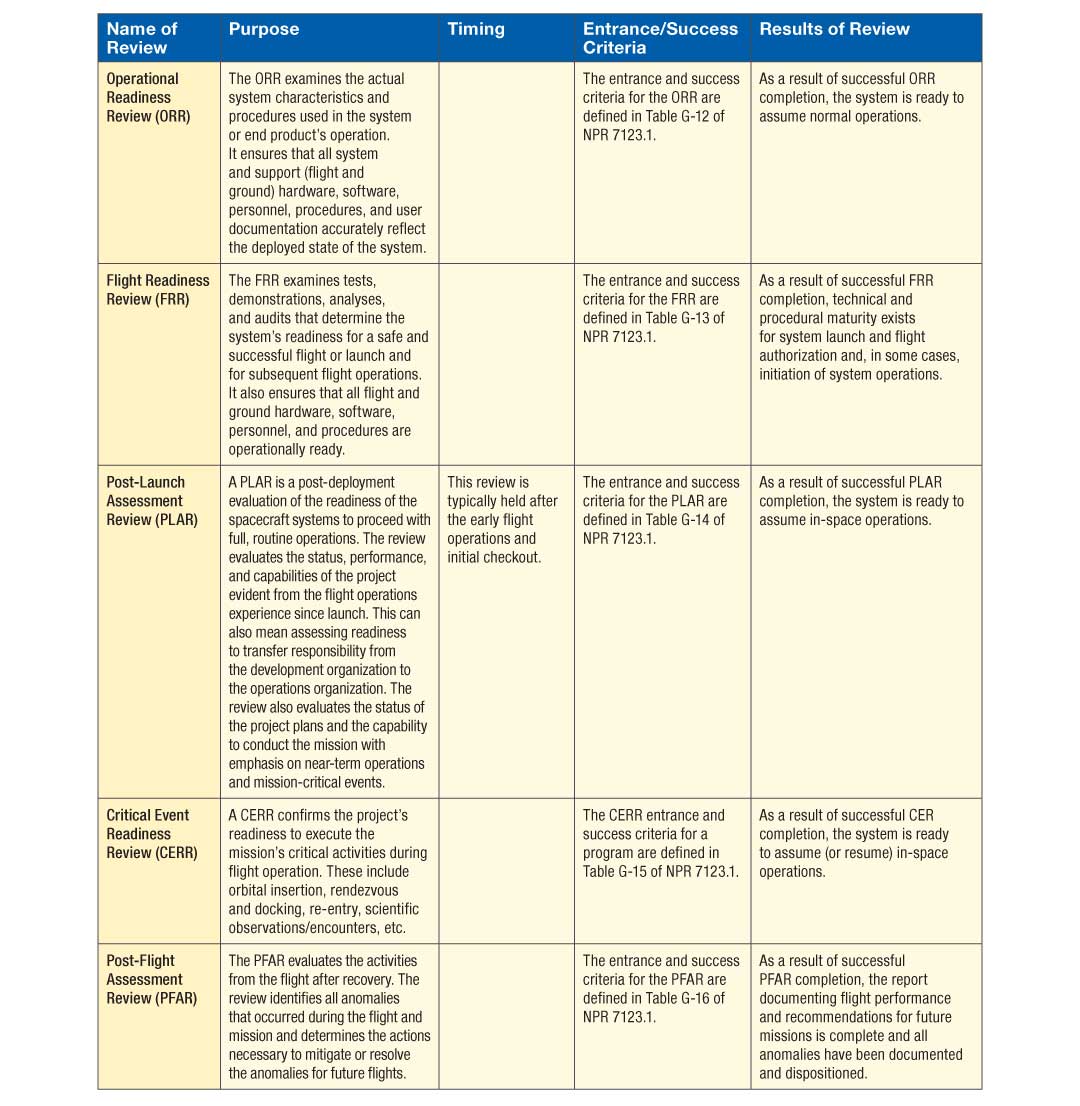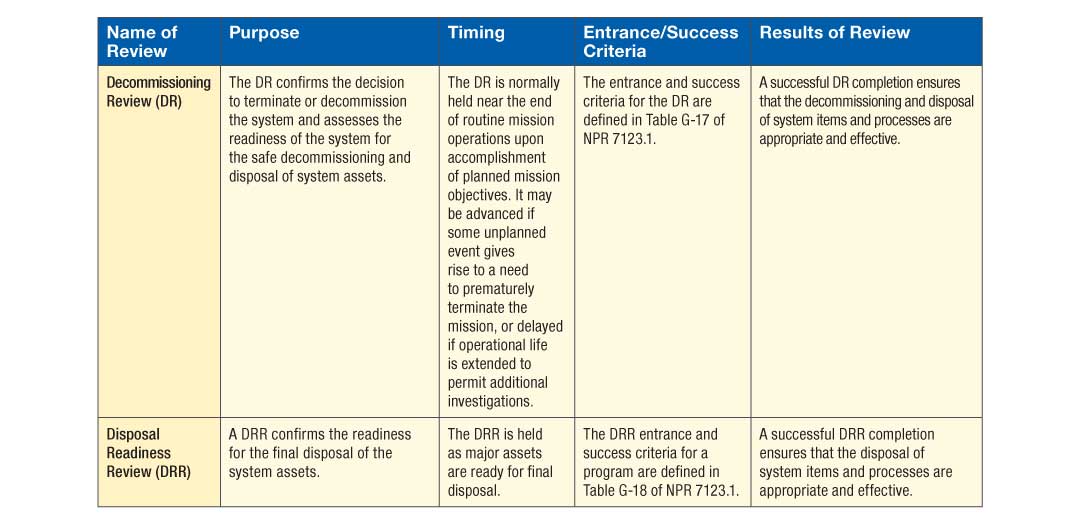6.1 Technical Planning
6.2 Requirements Management
6.3 Interface Management
6.4 Technical Risk Management
6.5 Configuration Management
6.6 Technical Data Management
6.7 Technical Assessment
6.8 Decision Analysis
Technical assessment is the crosscutting process used to help monitor technical progress of a program/project through periodic technical reviews and through monitoring of technical indicators such as MOEs, MOPs, Key Performance Parameters (KPPs), and TPMs. The reviews and metrics also provide status information to support assessing system design, product realization, and technical management decisions.
NASA has multiple review cycle processes for both space flight programs and projects (see NPR 7120.5), and research and technology programs and projects. (See NPR 7120.8, NASA Research and Technology Program and Project Management Requirements.) These different review cycles all support the same basic goals but with differing formats and formalities based on the particular program or project needs.
6.7.1 Process Description
Figure 6.7-1 provides a typical flow diagram for the Technical Assessment Process and identifies typical inputs, outputs, and activities to consider in addressing technical assessment. Technical assessment is focused on providing a periodic assessment of the program/project’s technical and programmatic status and health at key points in the life cycle. There are 6 criteria considered in this assessment process: alignment with and contribution to Agency strategic goals; adequacy of management approach; adequacy of technical approach; adequacy of the integrated cost and schedule estimates and funding strategy; adequacy and availability of non-budgetary resources, and adequacy of the risk management approach.
6.7.1.1 Inputs
Typical inputs needed for the Technical Assessment Process would include the following:
- Technical Plans: These are the planning documents that will outline the technical reviews/assessment process as well as identify the technical product/process measures that will be tracked and assessed to determine technical progress. Examples of these plans are the program (or project) plan, SEMP (if applicable), review plans (which may be part of the program or project plan), ILS plan, and EVM plan (if applicable). These plans contain the information and descriptions of the program/project’s alignment with and contribution to Agency strategic goals, its management approach, its technical approach, its integrated cost and schedule, its budget, resource allocations, and its risk management approach.
- Technical Process and Product Measures: These are the identified technical measures that will be assessed or tracked to determine technical progress. These measures are also referred to as MOEs, MOPs, KPPs, and TPMs. (See Section 6.7.2.6.2 in the NASA Expanded Guidance for Systems Engineering at https://nen.nasa.gov/web/se/doc-repository.) They provide indications of the program/project’s performance in key management, technical, cost (budget), schedule, and risk areas.
- Reporting Requirements: These are the requirements on the methodology in which the status of the technical measures will be reported with regard to management, technical cost (budget), schedule, and risk. The requirements apply internally to the program/project and are used externally by the Centers and Mission Directorates to assess the performance of the program or project. The methodology and tools used for reporting the status will be established on a project-by-project basis.
6.7.1.2 Process Activities
6.7.1.2.1 Prepare Strategy for Conducting Technical Assessments
As outlined in Figure 6.7-1, the technical plans provide the initial inputs into the Technical Assessment Process. These documents outline the technical reviews/assessment approach as well as identify the technical measures that will be tracked and assessed to determine technical progress. An important part of the technical planning is determining what is needed in time, resources, and performance to complete a system that meets desired goals and objectives. Project managers need visibility into the progress of those plans in order to exercise proper management control. Typical activities in determining progress against the identified technical measures include status reporting and assessing the data. Status reporting will identify where the project stands with regard to a particular technical measure. Assessing will analytically convert the output of the status reporting into a more useful form from which trends can be determined and variances from expected results can be understood. Results of the assessment activity then feed into the Decision Analysis Process (see Section 6.8) where potential corrective action may be necessary.
These activities together form the feedback loop depicted in Figure 6.7-2.
This loop takes place on a continual basis throughout the project life cycle. This loop is applicable at each level of the project hierarchy. Planning data, status reporting data, and assessments flow up the hierarchy with appropriate aggregation at each level; decisions cause actions to be taken down the hierarchy. Managers at each level determine (consistent with policies established at the next higher level of the project hierarchy) how often and in what form status data should be reported and assessments should be made. In establishing these status reporting and assessment requirements, some principles of good practice are as follows:
- Use an agreed-upon set of well-defined technical measures. (See Section 6.7.2.6.2 in the NASA Expanded Guidance for Systems Engineering at https://nen.nasa.gov/web/se/doc-repository.)
- Report these technical measures in a consistent format at all project levels.
- Maintain historical data for both trend identification and cross-project analyses.
- Encourage a logical process of rolling up technical measures (e.g., use the WBS or PBS for project progress status).
- Support assessments with quantitative risk measures.
- Summarize the condition of the project by using color-coded (red, yellow, and green) alert zones for all technical measures.
6.7.1.2.2 Assess Technical Work Productivity and Product Quality and Conduct Progress Reviews
Regular, periodic (e.g., monthly) tracking of the technical measures is recommended, although some measures should be tracked more often when there is rapid change or cause for concern. Key reviews, such as PDRs and CDRs, or status reviews are points at which technical measures and their trends should be carefully scrutinized for early warning signs of potential problems. Should there be indications that existing trends, if allowed to continue, will yield an unfavorable outcome, corrective action should begin as soon as practical. Section 6.7.2.6.1 in the NASA Expanded Guidance for Systems Engineering at https://nen.nasa.gov/web/se/doc-repository provides additional information on status reporting and assessment techniques for costs and schedules (including EVM), technical performance, and systems engineering process metrics.
The measures are predominantly assessed during the program and project technical reviews. Typical activities performed for technical reviews include (1) identifying, planning, and conducting phase-to-phase technical reviews; (2) establishing each review’s purpose, objective, and entry and success criteria; (3) establishing the makeup of the review team; and (4) identifying and resolving action items resulting from the review. Section 6.7.2.3 summarizes the types of technical reviews typically conducted on a program/project and the role of these reviews in supporting management decision processes. This section address the types of technical reviews typically conducted for both space flight and research and technology programs/projects and the role of these reviews in supporting management decision processes. It also identifies some general principles for holding reviews, but leaves explicit direction for executing a review to the program/project team to define.
The process of executing technical assessment has close relationships to other areas, such as risk management, decision analysis, and technical planning. These areas may provide input into the Technical Assessment Process or be the benefactor of outputs from the process.
Table 6.7-1 provides a summary of the types of reviews for a space flight project, their purpose, and timing.
6.7.1.2.3 Capture Work Products
The work products generated during these activities should be captured along with key decisions made, supporting decision rationale and assumptions, and lessons learned in performing the Technical Assessment Process.
6.7.1.3 Outputs
Typical outputs of the Technical Assessment Process would include the following:
- Assessment Results, Findings, and Recommendations: This is the collective data on the established measures from which trends can be determined and variances from expected results can be understood. Results then feed into the Decision Analysis Process where corrective action may be necessary.
- Technical Review Reports/Minutes: This is the collective information coming out of each review that captures the results, recommendations, and actions with regard to meeting the review’s success criteria.
- Other Work Products: These would include strategies and procedures for technical assessment, key decisions and associated rationale, assumptions, and lessons learned.
6.7.2 Technical Assessment Guidance
Refer to Section 6.7.2 in the NASA Expanded Guidance for Systems Engineering at https://nen.nasa.gov/web/se/doc-repository for additional guidance on:
- the basis of technical reviews,
- audits,
- Key Decision Points,
- required technical reviews for space flight projects,
- other reviews,
- status reporting and assessment (including MOEs, MOPs, KPPs, TPMs, EVM and other metrics,
Additional information is also available in NASA/SP-2014-3705, NASA Space Flight Program and Project Management Handbook.



























